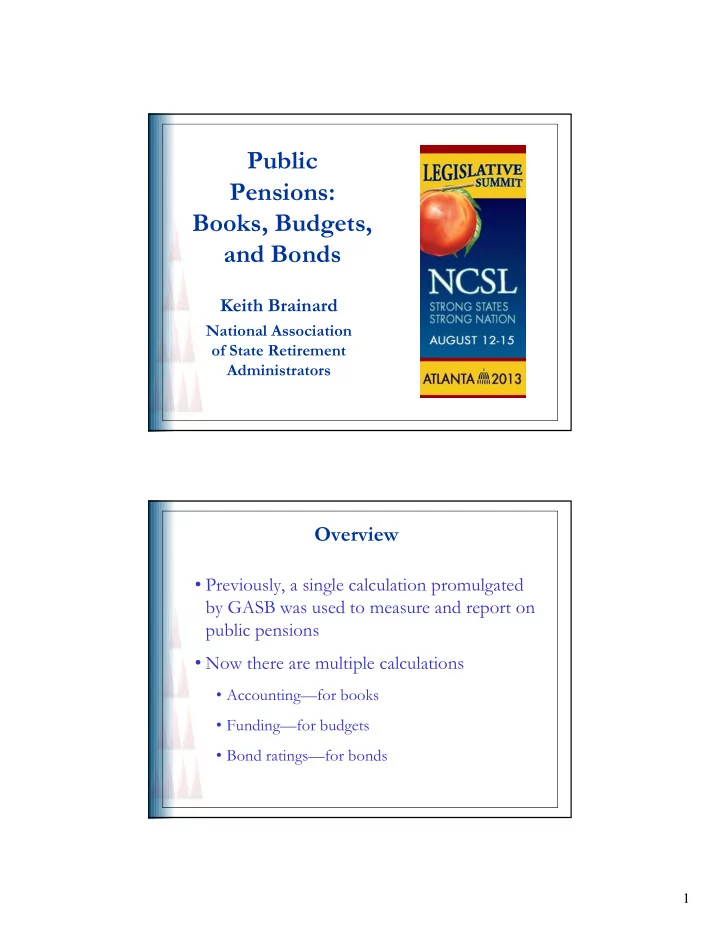

Public Pensions: Books, Budgets, B k B d t and Bonds Keith Brainard National Association i l A i i of State Retirement Administrators Overview • Previously, a single calculation promulgated by GASB was used to measure and report on by GASB was used to measure and report on public pensions • Now there are multiple calculations • Accounting—for books • Funding—for budgets • Bond ratings—for bonds 1
Calculating for Books • Promulgated by GASB for users of public sector financial statements • D i • Designed to present standardized financial reporting d t t t d di d fi i l ti of pensions for accounting purposes • A new figure, the Net Pension Liability , will be placed on basic financial statements of public employers • The NPL is essentially the difference between the market value of assets and total liabilities • The NPL in many cases will be relatively large and will dwarf other financial statement elements Calculating for Books (cont.) • GASB no longer will require or maintain parameters for an Annual Required Contribution for an Annual Required Contribution • If the retirement system calculates an actuarially determined contribution, that and the history of funding commitment must be reported • New GASB standards do not change the funding condition or the cost of public pensions di i h f bli i 2
Calculations for Funding • Policymakers need information regarding the annual cost to fund the pension plan • Pension plans covering most public employees have a funding policy rooted in actuarially determined costs • Funding guidelines have been developed by the • Pension Funding Task Force • California Actuarial Advisory Panel Calculations for Funding (Cont.) • States should have pension funding policies based on an actuarially determined contribution calculated i ll d i d ib i l l d within sound parameters – which will in turn be required supplementary information under new GASB standards. • The Government Finance Officers Association and the Conference of Consulting Actuaries are h C f f C l i A i developing best practices and guidelines that make similar recommendations and provide more specificity 3
Calculating for Bond Ratings • Bond ratings agencies develop their own methods for assessing the creditworthiness of issuers of municipal debt; pension obligations are but one component of pension obligations are but one component of creditworthiness • Some agencies restate pension data, generally based on more conservative assumptions • Restatements do not comport with GASB requirements (new or old), and are not meant to be used for funding purposes • Of the three major ratings agencies, Moody’s and Fitch have established methodologies that rely on calculations not based on GASB calculations • S&P’s ratings remain based on outgoing GASB standards Calculating for Bond Ratings (continued) • Moody’s now applies • A uniform, taxable discount rate (currently around 4.5%) • A uniform 20 year amortization period • A uniform, 20-year amortization period • Market value of assets (no smoothing) • Attribution of pension liabilities to employers in cost-sharing plans proportionate to payroll • Fitch applies a uniform 7% discount rate and considers contribution effort and the reasonableness of assumptions • Moody’s and Fitch combine unfunded pension liabilities with states’ debt to create rankings • Standard & Poor’s relies on traditional metrics: funding ratio, funding level, unfunded liabilities per capita and as a percentage of income 4
Conclusion • Multiple pension calculations have replaced the single GASB driven numbers the single GASB-driven numbers • Calculations are being made for different purposes and different audiences • Stakeholders should recognize the meaning, purpose, and target audience for each d d calculation 5
Recommend
More recommend